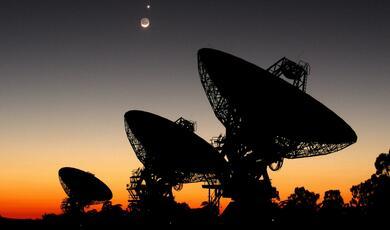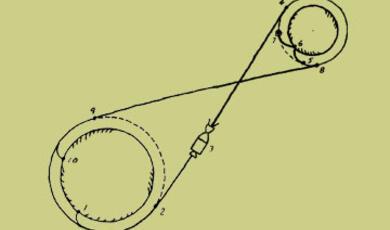The Search for Other Worlds
Share
- Details
- Text
- Audio
- Downloads
- Extra Reading
One of the hottest topics in astronomy is that of detecting other solar systems. The methods by which this has been achieved so far have yet to detect an earth-like planet, but already a miniature version of our solar system has been discovered. How do these discoveries affect the prospects for life elsewhere?
Download Text
THE SEARCH FOR OTHER WORLDS
Professor Ian Morison
This is one of the most exciting areas of research being undertaken at the present time with the discovery of new planets being announced on a monthly basis. This lecture will describe the techniques that are being used to discover them and then discuss their properties. Perhaps a word of warning might be in order. An obvious quest is to find planetary systems like our own which could, perhaps, contain planets that might harbour life. So far, to many astronomers' surprise, the vast majority of solar systems found have been very unlike our own which might lead one to the conclusion that solar systems like ours are very rare. The author has even heard this point of view put forward by an eminent astro-biologist. At this time, one should not draw this conclusion. For reasons which shortly become apparent, the techniques largely used to date would have found it very difficult to detect the planets of our own solar system so it should not be surprising that we have so far failed to find many other similar solar systems. As new techniques are used, this situation will improve, but it will be many years before we have any real idea how often solar systems like our own have arisen in the galaxy. The story of the discovery of the first planet to orbit a sun-like star is very interesting in its own right, but, in order to appreciate its nuances, we need first to understand how this, along with the great majority of planets so far detected, has been discovered.
The visual detection of planets orbiting normal stars.
It has been long thought that the detection of planets by direct imaging was not feasible due to the fact that the light reflected from the planet would be lost in the glare of the light from the star.
In the infrared, stars are less bright than in the visible and the brightness difference is reduced, so making detection easier. In fact, a planetary sized body had been detected in orbit around a brown dwarf. This had been achieved using one of the 8m telescopes of the VLT in Chile with the use of adaptive optics to correct for atmospheric turbulence. This is very effective in the infrared and so allows telescopes to achieve higher resolutions and thus allow planets at small angular distances from their star to be seen.
Planets observed in the infrared
In November 2008, a team of astronomers using the 10m Keck and 8m Gemini-North telescopes announced the discovery of three planets orbiting the, 129 light year distant, star HR 8799. Again, the observations were made in the infrared and, in addition, an occulting device was used to remove much of the light from the star.
An infrared image showing three planets in orbit around the star HR8799.
HR8799 is quite close to the position in the sky of 51 Pegasai, the first sun-like star to have a planet discovered in orbit around it. The three planets are several times the mass of Jupiter and even the closest has an orbital radius equal to the Sun-Neptune distance of ~30 AU.
A planet discovered in visible light by the Hubble Space Telescope
In a discovery first, the detection of a planet in visible light was also announced in November 2008. The discovery was based on two observations, in 2004 and 2006, of the star Formalhaut that lies at a distance of 25 light years from our Sun.
A composite of two images of the Formalhaut star system.
Again, an occulting disk was used to largely eliminate the light form the star. Beyond the scattered "starlight noise" is seen a prominent dust ring. To the lower right of the star's position a faint object was imaged which was seen to move in the two years between the observations. This is the planet Formalhaut b which is ~ 3 Jupiter masses and orbits Formalhaut at a distance of ~10.7 billion miles or 73 AU. It is thus the first planet ever to have been imaged in visible light.
Will this method detect many planets?
All four planets are several times the mass of Jupiter (and hence relatively bright) and lie at great distance from their star. Both stars are not that far distant so the angular separation of the planets from their stars enabled them to be distinguished from the remnant starlight. It does not seem likely that planets of the size and distance from their star of our Earth could be detected by this method, but observations, either from Earth or space, might well be able to detect a significant number of planets in the future.
The Radial Velocity (Doppler wobble) method of Planetary Detection.
Our own solar system gives us a good insight into this method and its strengths and weaknesses. Astronomers often use, as in this book, the phrase 'the planets orbit the Sun'. This is not quite true. Imagine a scale model of the solar system with Sun and planets having appropriate masses and positions in their orbits from the Sun. All the objects are mounted on a flat, weightless, sheet of supporting material. By trial and error, one could find a point where the model could be balanced on just one pin. This point is the centre of gravity of the solar system model. The centre of gravity of the solar system is called its barycentre, andboth the Sun and planets rotate about this position in space.
As Jupiter is more massive than all the other planets combined, its mass and position have a major effect on the position of the barycentre, which will thus lie a distance from the centre of the Sun in the approximate direction of Jupiter. How far might this be?
Ignoring all other planets, let us assume that the barycentre lies R km from the centre of the Sun. The mass of the Sun and Jupiter must 'balance' about this point so, given R and the semi major axis of Jupiter's orbit in km:
MSun x R = MJupiter x (777,547,199 - R)
The Sun, with a mass of 2 x 1030 kg, is approximately 1000 times more massive than Jupiter. Hence:
1000 R + R = 777,547,199
so, R = 777,547,199 / 1001
= 776,770 km
The equatorial radius of the Sun is 695,500 km so, if Jupiter is were its only planet, the barycentre of the solar system would actually lie outside the Sun. When all of the major planets lie on one side of the Sun, as happened in the 1980's - allowing the Voyager spacecraft missions to the outer planets - the barycentre is further from the Sun's centre and when Jupiter is on the opposite side to the other planets it is nearer the Sun's centre. On average, the barycentre is at a distance of ~1.25 solar radii from the Sun's centre, varying between extremes of ~0.3 and 2 solar radii.
Suppose that we observed the Solar System from a point at a great distance in the plane of the solar system. We could not see the planets - their reflected light would be swamped by the light from the Sun - but, at least in principle, we could detect their presence. Due to the Sun's motion around the barycentre of the Solar System, it would at times be moving towards us and at other times moving away from us. If we could precisely measure the position of the spectral lines in the solar spectrum we could measure the changing Doppler shift and convert that into a velocity of approach or recession. The Solar System as a whole might, of course, be moving either away or towards us so we would see a cyclical change in velocity about a mean value.
The change in wavelength of a spectral line as the star orbits the barycentre of its solar system.
Again, for the sake of simplicity, let us assume that our Solar System has only one planet: Jupiter.
The Sun would be seen to rotate around the barycentre once every 11.86 years, the period of Jupiter's orbit. Given our calculation of the position of the barycentre, we can thus calculate the speed of the Sun in its orbit about the barycentre. The circumference of the Sun's orbit about the barycentre is:
2 x π x 7.77 x 105 km = 4.9 x 106 km = 4.9 x 109 m.
So, as 11.86 years is 3.74 x 108, seconds the orbital speed is:
4.9 x 109 / 3.74 x 108 = 13 m/sec.
This would mean that the difference between the maximum and minimum velocities would be ~ 26 m/s.
The current precision in Doppler measurements is of order of 2-3 m/s, but the hope is that, in time, this might improve to ~0.5 m/s. Very high resolution spectrometers are used to observe the light from the star whose light is first passed through a cell of gas to provide reference spectral lines to allow the Doppler shift to be measured.
The measurement accuracy of this method would thus be sufficient to detect the presence of Jupiter in orbit around the Sun. However, in order to be reasonably sure about any periodicity in the Sun's motion one would need to observe for at least half a period and preferably one full period. So observations have to be made on a time scale of many years in order to detect planets far from their sun. This is the major reason why few planets in large orbits have yet been detected - the observations have simply not been in progress for a sufficiently long time. But there is one other limitation that you might have realised: should we observe a distant solar system from directly above or directly below, then we would see no Doppler wobble and hence could not detect any of its planets. Unless we have additional information that can tell us the orientation of the orbital plane of a distant solar system, we can only measure the minimum mass of a planet, not its actual mass. If, for example, we later observed such a planet transit across the face of its sun then we would know that the plane of its solar system included the Earth so that the derived mass is the actual mass of the planet, rather than a lower limit.
A single planet in a circular orbit will give rise to a Doppler curve which is a simple sine wave. If the orbit of the planet is elliptical, a more complex, but regularly repeating Doppler curve results. In the case of a family of planets, the Doppler curve is complex and will not repeat except on very long time scales. It can, however, still be analysed to identify the individual planets in the system.
In a manner similar to the way in which we calculated the orbital motion of the Sun due to Jupiter, one could calculate Sun's orbital velocity due to the Earth. This is 0.1 m/s, well below the current and predicted future sensitivity of the radial velocity method so other methods are required for the detection of Earth-like planets. As other techniques - discussed below - come to fruition and longer periods of observation are analysed by the radial velocity method, solar systems like our own are beginning to be found - but, as yet, we cannot say how common they are.
Pulsar Planets
There is one case where Doppler measurements can be made to extreme accuracy. This is when the central object is the remnant of a giant star called a neutron star. These will be discussed in detail in the chapter on stellar evolution, but all we need to know at this instance is that some of these stars (called Pulsars) emit regular, very precisely timed, pulses and so Doppler shifts can be measured to exceedingly high precision. This, in principle, would easily allow earth-mass planets to be discovered. However, it is thought that planets would not often survive the massive nuclear explosion - called a supernova - when the pulsar is formed, so such planets are likely to be very rare. However, in 2006 observations made using the Spitzer Space Telescope showed that the pulsar 4U 0142+61 had a circumstellar disk. The disk is thought to have formed from metal-rich debris left over from the supernova explosion that had given rise to the pulsar and is similar to those seen around Sun-like stars, suggesting that planets might be able to form within it. Pulsars emit vast amounts of electromagnetic radiation so such planets would be totally incapable of supporting any form of life!
This is perhaps how the planets were formed in orbit around the pulsar B1257+12. Two planets were initially discovered in 1992 by Aleksander Wolszczan and Dale Frail. Their orbits would both fit within the orbit of Mercury and they had masses of 4.3 and 3.9 Earth masses. Two further planets with masses of just 0.004 and 0.02 Earth masses have since been found in the system and, more recently, a single 2.7 Jupiter-mass planet has been found in orbit around the pulsar B1620-26. It is possible that three other pulsars have one or more planets in orbit around them, but these have yet to be confirmed.
Planets orbiting the Pulsar PSR 1257+12 at distances of 0.19, 0.36 and 0.46 AU.
The discovery of the first planet around a sun-like star.
In 1988, Canadian astronomers, Bruce Campbell, G. A. H. Walker, and S. Yang, suggested from Doppler measurements that the star Gamma Cephei might have a planet in orbit about it. The observations were right at the limit of their instruments capabilities and were largely dismissed by the astronomical community. Finally, in 2003, its existence was confirmed but, unfortunately, this was many years after the first confirmed discovery of a planet around a main sequence star.
Two American astronomers, Paul Butler and Geoffrey Marcy, were the first to make a serious hunt for extra-solar planets. They began observations in 1987 but, assuming that other planetary systems were similar to our own, did not expect that any planets could be extracted from the data for several years. They would have thus been somewhat shocked when the discovery of a planet orbiting a star called 51 Pegasai was announced by Michael Mayor and Didier Queloz on October 6, 1995. The star 51 Pegasi, or 51 Peg for short, lies just to the right of the square of Pegasus and is a type G5 star, a little cooler than our Sun, with a mass of 1.06 solar masses. Meyer and Queloz were studying the pulsations of stars, which also causes a Doppler shift in the spectral lines as the star 'breathes' in and out. With a sensitivity of only 15 m/s they had not really expected to discover planets but, greatly to their surprise, they found a periodicity in the motion of the star 51 Peg having a period of 4.23 days and a velocity amplitude of 57 m/s. The plot is very close to a sinusoid showing that the orbit is very nearly circular.
Radial velocity measurements of 51 Pegasai made by Korzennik and Contos using the Advanced Fiber Optic Echelle Spectrometer on the 1.5 m Telescope at the Whipple Observatory near Tuscon, Arizona.
Let us calculate the mass and orbital radius of the planet which is called 51 Pegasi b. From the velocity of the star and the period of the orbit we can first calculate the circumference and hence the radius of the star's motion. 4.23 days is 365,472 seconds, so the circumference is 57 x 365,472 m = 20,831,904 m, giving a radius of 3,315,500 km. This is thus the distance from the centre of the star to the barycentre of the system.
You may remember that we were able to calculate the mass of the Sun given the orbital period and the distance of the Earth from the Sun:
M = 4π2a3 / GP2
Note: this slightly simplified equation assumes the mass of the planet is far less than that of the star.
As we know the mass of the star 51 Peg, (M = 1.06 x 2 x1030kg), and the period P, we can solve this equation for a, the distance of the planet from the star, given the universal constant of gravitation, G.
a = (GM P2 / 4π2)1/3
Substituting:
= (6.67 x 10-11 x 2.12 x 1030 x (365,472)2 / 4π2)1/3 m
= 7.82 x 109 m
One AU is 1.496 x 1011 m so the planet lies at a distance of 0.052 AU from 51 Peg - this is well within the distance of 0.39 AU at which Mercury orbits our Sun and only about 10 times the radius of the star.
We can now find the mass of the planet by balancing about the barycentre of the system, which we have calculated lies at a distance of 3,315,500 km from the centre of the star. We have:
Mplanet x 7.81 x 109 = Mstar x 3,315,500
Giving the mass of the planet as:
Mplanet = 2.12 x 1030 x (3,315,500 / 7.81 x 109 ) kg
= 9 x 1026 kg
Jupiter has a mass of 1.9 x 1027, so the planet has a calculated mass of 0.47 that of Jupiter.
However, this would only be the mass of the planet if the plane of its orbit included the Earth and will thus be the planet's minimum mass. One can show that, for random orientations, the mass of a planet will on average be about twice the minimum mass, so the planet in orbit around 51 Peg is likely to be very similar in mass to Jupiter.
When Butler and Marcy learnt about this discovery, they realized that not only could they confirm its presence from several years observations of 51 Peg in their database - which they did just six days later - but that if other massive planets with short periods existed around the stars that they had been observing, they should be able to rapidly find these as well. This hope was born out and, to date, they have been the world's most prolific planet hunters.
No-one had expected that a gas giant would be found so near its star, but many of the planets first discovered were similar in size and separation from their sun. It is not thought that giant planets can form so close to a star, so at some time in their early history it is assumed that they must have migrated inwards through the solar system. In doing so, they would very likely eject smaller (terrestrial type) planets that had formed nearer the star from the solar system and consequently these solar systems are thought unlikely to harbour life.
The Doppler wobble method has proven to be highly successful, but even with a hoped-for velocity precision of 0.5 to 1 m/s at best, the method will never be able to detect Earth-mass planets, no matter how close they are to their sun.
Planetary Transits.
As the number of known close orbiting gas-giants increases, there becomes a reasonable chance that the plane of some of their orbits will include the Earth and so, once each orbit, the planet might occult the star, giving a measurable drop in its brightness.
The effect of a planetary transit on the brightness of a star.
Let us estimate the magnitude drop if a Jupiter sized planet occulted our Sun as seen from a great distance. The Sun has a diameter which is ~10 times that of Jupiter, so that its cross sectional area will be ~100 times that of Jupiter. When Jupiter occulted the Sun, the effective area will drop from 100 to 99 - a ratio of 0.99 - and give a drop in brightness of 1%. This corresponds to a magnitude drop given by:
Δm = 2.5 log10(0.99)
= -0.011 magnitudes.
With care, such accuracy in measurement is achievable and on November 5th 1999 two teams detected the transit of a planet, previously discovered by the radial velocity method, in orbit around the star HD 209469. During the transit, the brightness of the star dropped by 1.7%.
In 2002, a planet OGLT-TR-56b was discovered by the transit method and later confirmed using the radial velocity method. Then, in 2006, the Hubble Space Telescope made a survey of 180,000 stars up to 26,000 light-years away towards central bulge of our galaxy. The survey discovered 16 candidate extra-solar planets of which three have since been confirmed. Such confirmation is required as the technique has a high rate of false detections. If all 16 were confirmed, it would imply that there would be of order six thousand million Jupiter sized planets in the galaxy. Five of the newly discovered planets were found to orbit their sun with periods of less than one day. The candidate with the shortest period - just 10 hours - is only 1.2 million km from its relatively small, red dwarf sun and has an estimated surface temperature of 1400 K! It must be at least 1.6 times the mass of Jupiter in order to prevent the tidal forces from the star splitting the planet apart.
An artist's impression of a transiting exoplanet.
Apart from the high rate of false detections the transit method has the problem that transits can only be observed when the planet's orbit is nearly edge on. About 10% of planets in close orbits would show transits, but the fraction is far smaller for planets with large orbits as the alignment has to be more precise - only ~0.5% of earth-like planets in orbit around stars similar to our Sun would cause transits. Two space missions called Kepler and COROT will have very large field of views, enabling them to continuously monitor many stars. The 95 Megapixel CCD array (!) used with the 0.95 m Kepler telescope will monitor more than 100,000 stars with very high precision during an initial 3.5 year observing period. It is hoped that Kepler and COROT will, for the first time, enable the detection of a significant number of earth-sized planets.
The transit method does have two significant advantages. The first is that, as a planet will take some time to fully cover its star, the size of the planet can be determined from the light curve. When combined with the planet's mass, determined by the radial velocity method, the density of the planet can be determined and so we can learn about its physical structure.
The second advantage is that it is possible to study the atmosphere of a planet. When the planet transits the star, light from the star passes through the atmosphere of the planet. By carefully studying the star's spectrum during the transit, absorption lines will appear that relate to elements in the planetary atmosphere.
The extrasolar planet HD 209458b, provisionally nicknamed Osiris, was the first planet observed transiting its sun. Observations by the Hubble Space Telescope (HST) first discovered a tail of evaporating hydrogen which may, in time, completely strip the planet of gas leaving a "dead" rocky core. More recent HST observations have shown that the planet is surrounded with an extended envelope of oxygen and carbon believed to be in the shape of a rugby-ball. These heavier atoms are caught up in the flow of the escaping atmospheric atomic hydrogen and rise from the lower atmosphere rather like dust in a whirlwind.
Gravitational Microlensing
The detection of earth-mass planets by the transit method still lies in the future, but there is a third method which has the potential to achieve this now - and has already detected a 5 earth-mass planet. Einstein's General Theory of Relativity was proven by the observed movement of star's positions due to the curvature of space close to the Sun. This effect gives rise to what is called gravitational lensing, specifically gravitational micro-lensing as the effects are on a very small scale. In the same way that a convex lens can concentrate the light from a distant object into the eye and so make it appear brighter, if a distant star passes behind one of intermediate distance, the brightness of the distant star will undergo a temporary increase which can last for many days. The peak brightness can be up to 10 times (2.5 magnitudes) that normally observed. More than a thousand such events had been observed by the end of 2008.
If the lensing star has a planet in orbit around it, then that planet can produce its own microlensing event, and thus provide a way of detecting its presence. For this to be observed, a highly improbable alignment is required so that a very large number of distant stars must be continuously monitored in order to detect planetary microlensing events. Observations are usually performed using networks of robotic telescopes (such as those that forming the OGLE collaboration) which continuously monitor millions of stars towards the center of the galaxy in order to provides a large number of background stars.
Observations by the OGLE consortium showing the microlensing caused by a planet of 5.5 earth-masses.
If one of the telescopes finds that the brightness of a star is increasing, then the whole network, spaced around the world for continuous observation, will provide unbroken monitoring. The presence of a planet is shown by a very short additional brightening appearing as a spike on the flanks of the main brightness curve.
On January 25, 2006, the discovery of OGLE-2005-BLG-390Lb was announced. This planet is estimated to have a mass of ~5.5 earth-masses and orbits a red dwarf star which is around 21,500 light years from Earth, towards the center of the Milky Way galaxy. The planet lies at a distance of 2.6 AU from its sun. At the time of its discovery, this planet had the lowest mass of any known extra-solar planet orbiting a main sequence star. This record may still hold unless the mass of Gliese 581 c, discovered in April 2007 by the radial velocity method, is found to have a mass very close to its minimum mass of 5 earth-masses. By the end of 2007, four extra-solar planets had been discovered using the microlensing technique.
Artists Impression of the 5.5 earth-mass planet which circles its red dwarf star with a period of 10 years.
The planet has surface temperature of ~220 degrees Centigrade below zero. It is likely to have a thin atmosphere with a rocky core buried beneath a frozen icecap. Image: ESO press release March 2006.
A disadvantage of the method is that the chance alignment that allowed the lensing event that led to the planet's detection is highly unlikely to be ever repeated. Also, the detected planets will tend to be many thousands of light years away, so making any follow-up observations by other methods virtually impossible. However, if enough background stars can be observed over long periods of time the method should finally enable us to estimate how common earth-like planets are in the galaxy.
In early 2008, the gravitational microlensing method detected two gas giant planets, similar to Jupiter and Saturn, orbiting a star 5000 light-years away in a planetary system with striking similarities to our own Solar System. The discovery suggests that giant planets do not live alone but are more likely to be found in family groups. The mass of the nearer planet is 0.71 times that of Jupiter and it lies 2.3 times as far from its host star as the Earth is from the Sun. The second planet is less massive, 0.27 times the mass of Jupiter, and twice as far away from the host star. Later, in June 2008, the smallest extra-solar planet yet discovered was announced. It is just 3 earth masses, but it is orbiting a brown dwarf some 3000 light years from Earth rather than a normal star.
Despite their host star only being half as massive as the Sun the planetary system otherwise bears a remarkable similarity to our Solar System. Both the ratio of the masses of the two giant planets (close to 3:1) and the ratio of their distances from the host star (1:2) are remarkably similar to those of Jupiter and Saturn. The ratio between the orbital periods of 5 years and 14 years, respectively, also closely resembles that between Jupiter and Saturn (2:5). The newly discovered system resembles our own Solar System more closely than any previously observed. Whilst there are more than 250 planets now known to be orbiting other stars, there are only about 25 solar systems known to have multiple planets - but this number will surely rise as smaller planets fall within our detection methods.
Astrometry
The science of accurate positional measurement, called astrometry, is the oldest method that has been employed in the search for planets and in the 1950's and 1960's the discovery of several planets was claimed using this method. Sadly, none has since been confirmed and, by the end of 2007 no planets had been discovered by this method, though the Hubble Space Telescope has confirmed the existence of a planet in orbit around Gliese 876.
The method consists of observing, with great precision, how a star's position varies over time. All star systems are moving around the galaxy (our Sun in ~ 230 million years) and over short periods of time will move in essentially straight lines. But, as I hope you might realize, if the star is in a binary or planetary system, the point that moves in a straight line is not the centre of the star but the barycentre of the system. So, as the star moves in a tiny circular or elliptical orbit about the barycenter, it will follow a wiggly path across the sky. As yet, except in the case of Gleise 876, it has not been possible to produce observations of sufficient accuracy to allow the presence of a planet to be detected. A simple calculation might indicate why this is so. Consider the star 51 Pegasi. It lies at a distance of 3,315,500 km from the barycentre of its planetary system. Assuming that we are at right angles to the plane of its planet - which is the most favourable condition - then we could calculate the amplitude of the angular oscillation that would be observed as 51 Pegasi moves across the heavens. (Note that if the plane of 51 Pegasi's planet was at right angles to us, the radial velocity method could not have detected it!)
Let us take a distance for the star system of 30 light years which is ~3 x 1014 km. The angular motion in radians is thus ~ 3 x 106 / 3 x 1014radians, which is 1 x 10-8 radians or 0.002 arc seconds. The angular resolution of the Hubble Space Telescope (HST) is 0.05 arc seconds but a very clever technique has enabled it to make measurements with a positional accuracy of 0.0005 arc seconds and so it would be able to detect the planet around 51 Pegasi. As mentioned, the HST has been able to detect the planet in orbit around Gliese 876, which lies at a distance of 15.6 light years and was first detected with the radial velocity method in 1998. The radial velocity measurements combined with two years of the HST astrometric measurements allow the orientation of the plane of the planetary orbits to be determined so that the actual, not just the minimum, mass of the planets in that system has been found.
Future spacecraft, such as NASA's Space Interferometry Mission (SIM), should finally attain a measurement precision of 1 micro arc second or 0.000001 arc seconds. The mission would thus have the capability to detect planets at considerably greater distance than 30 light years.
The astrometric method nicely complements the radial velocity and transit methods in that it is more sensitive to planets at larger orbital distances. However such planets will have long orbital periods so observations over many years would be required for their detection.
Selection effects and the likelihood of finding solar systems like ours
As at the end of 2008, the vast majority of the extra-solar planets found have high masses - many considerably more massive than Jupiter. Only six have masses less than ten times that of the Earth. However, as all the detection methods described above are far more likely to discover massive planets, this is largely an observational selection effect. It is encouraging that despite the great difficulty of detecting them, astronomers have found several planets only a few times more massive than Earth. This implies that such planets are actually quite common. The other selection effect is that there has only just been enough time since radial velocity observations began to detect Jupiter mass planets at similar distances from their sun. It may very well be that solar systems like ours are quite common despite what might appear at first sight.
©Professor Ian Morison, Gresham College, 22 January 2008
This event was on Thu, 22 Jan 2009
Support Gresham
Gresham College has offered an outstanding education to the public free of charge for over 400 years. Today, Gresham College plays an important role in fostering a love of learning and a greater understanding of ourselves and the world around us. Your donation will help to widen our reach and to broaden our audience, allowing more people to benefit from a high-quality education from some of the brightest minds.


 Login
Login








